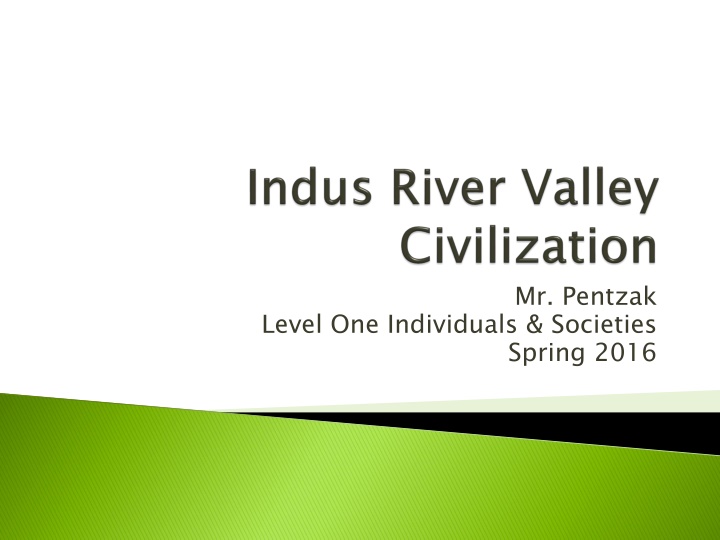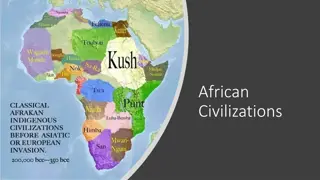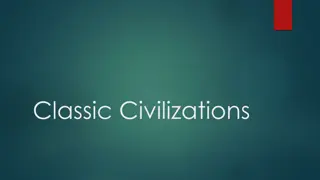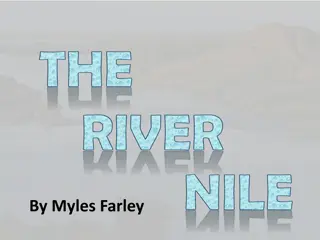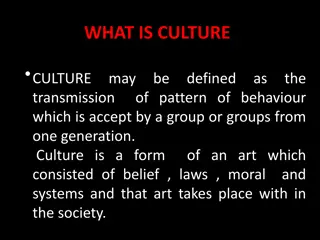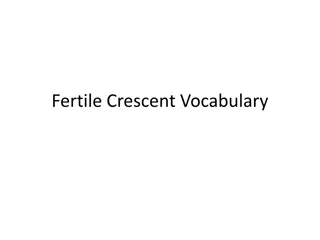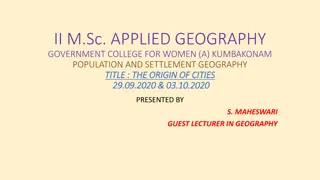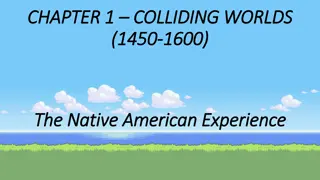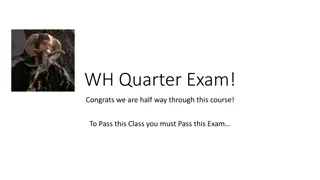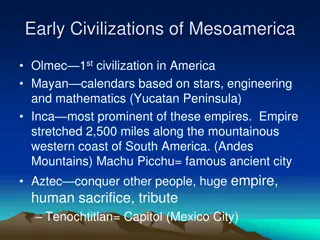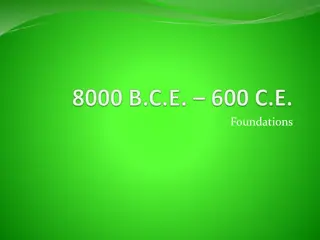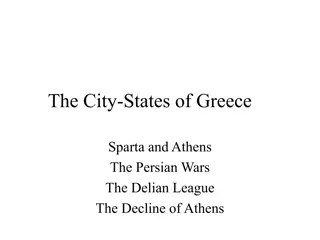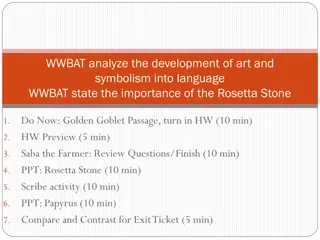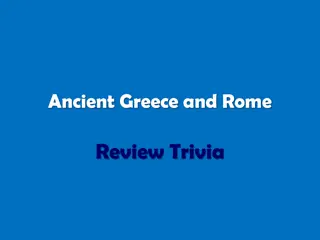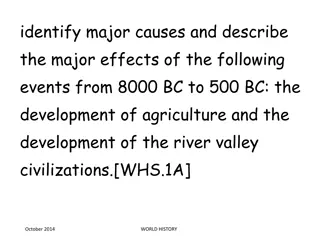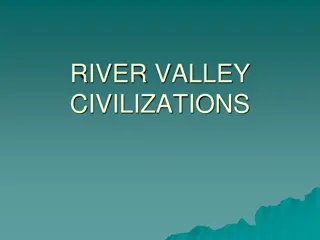Ancient Civilizations Studies and Group Activities
Explore the similarities between Mesopotamia and Ancient Egypt, make predictions about another ancient civilization, engage in group activities like reading chapters, answering questions, and playing Vocab Alive. Learn about key terms like Monsoon, Sanskrit, Caste System, and more. Collaborate in small groups to enhance learning experiences.
Download Presentation

Please find below an Image/Link to download the presentation.
The content on the website is provided AS IS for your information and personal use only. It may not be sold, licensed, or shared on other websites without obtaining consent from the author.If you encounter any issues during the download, it is possible that the publisher has removed the file from their server.
You are allowed to download the files provided on this website for personal or commercial use, subject to the condition that they are used lawfully. All files are the property of their respective owners.
The content on the website is provided AS IS for your information and personal use only. It may not be sold, licensed, or shared on other websites without obtaining consent from the author.
E N D
Presentation Transcript
Mr. Pentzak Level One Individuals & Societies Spring 2016
Name at least three things Mesopotamia had in common with Ancient Egyptian Civilization We are about to study another ancient civilization. Make some predictions about this civilization (starting points: geography, religion, matriarchal vs. patriarchal, social structures, etc.)
Open your Macbooks, and go to www.kahoot.it Wait for game pin on SMARTBoard Come up with a school appropriate This is a pre-test Do ya think you ll see similar questions again?! ;) school appropriate nickname
I will divide you into small groups In your groups, you will popcorn read this textbook chapter (found on my homework page) Each group will answer one question assigned by Mr. Pentzak Be prepared to share out responses! If we are quick, we can play Vocab Alive! Homework is to reread chapter independently and take Cornell Notes
Monsoon-Major wind system that seasonally reverses its direction that brings heavy rainfall in summer Sanskrit-an ancient Indo-Aryan language that is the classical language of India and of Hinduism Sub-continent-a large, relatively self-contained landmass forming a subdivision of a continent Dravidian-The indigenous population of India that were displaced by the Aryans c. 1500 BCE Aryan- Indo-European nomadic group that invaded the IRVC, bringing their religious & cultural beliefs to India Hierarchy- a system or organization in which people or groups are ranked one above the other according to status or authority. Indigenous- originating or occurring naturally in a particular place; native. Caste System-a system rigid social stratification characterized by hereditary and social status sanctioned by custom, law, or religion. Pariah-A social outcast Famine-extreme scarcity of food 6. 1. 7. 2. 8. system of 3. 9. 4. 5. 10.
Divide yourselves into ten groups (2-3 students per group depending on class size) I will assign you a vocab word Your group must come up with an action that represents the meaning of the word When it is your turn, read your definition and show the class your action Next group will repeat the word and action, then add their word, definition, and action Repeat until the end of the vocab list
What was the most likely cause of the collapse of the Indus River Civilization? Aliens Monsoons Tectonic Shift/Earthquakes Volcanic Eruption Which is an example of how Indus Valley cities were well planned? Well planned gridded streets Complex drainage and sewage systems Massive networks of levees, dams, and manmade islands All of the above True or False, the people of the Indus Valley did not trade with others? The Indus River Valley civilization was located in what modern day countries? India and Pakistan Egypt and Ethiopia Iran and Iraq Indonesia and the Philippines True or False, the language of the Indus River Valley Civilization has been deciphered? 1. a) b) c) d) 2. a) b) c) d) 3. 4. a) b) c) d) 5. BONUS- What brightly colored cloth was a desirable trade item because few people knew how to grow it?
What was the most likely cause of the collapse of the Indus Valley Civilization? Aliens Tectonic Shift/Earthquakes Monsoons Volcanic Eruption Which is an example of how Indus Valley cities were well planned? Well planned gridded streets Complex drainage and sewage systems Massive networks of levees, dams, and manmade islands All of the above True or False, the world s tallest mountain range is a natural boundary of the Indus River Valley? The Indus River Valley civilization was located in what modern day countries? Egypt and Ethiopia Indonesia and the Philippines India and Pakistan Iran and Iraq Another name for the Ancient Indus River Valley Civilization is Hairpin Harappan India All of the above BONUS- About how many symbols make up the language of the Indus River Valley? 1. a) b) c) d) 2. a) b) c) d) 3. 4. a) b) c) d) 5. a) b) c) d)
What was the most likely cause of the collapse of the Indus Valley Civilization? Aliens Tectonic Shift/Earthquakes Monsoons Volcanic Eruption What weather system did the IRVC rely on for agriculture? Typhoons Hurricanes Tornados Monsoons True or False, the world s tallest mountain range is a natural boundary of the Indus River Valley? The Indus River Valley civilization was located in what modern day countries? Egypt and Ethiopia Indonesia and the Philippines India and Pakistan Iran and Iraq Another name for the Ancient Indus River Valley Civilization is Hairpin Harappan India All of the above 1. a) b) c) d) 2. a) b) c) d) 3. 4. a) b) c) d) 5. a) b) c) d) BONUS- What is the other major river on the Indo-Gangetic Plain?
Take out your Vocabulary List 4 flashcards Who were the first group of people living in India? Who eventually takes them over? What weather system did the IRVC depend on to bring rain? If they received too much, or too little, what could be the result (vocab word)? Turn to a neighbor and quiz each other
Group One: Dravidians- The indigenous population of India. Makers of the Harappan/IRV Civilization. Not much is known about them because we cannot understand their written language. They were very advanced and built huge cities. Vast empire came to a sudden halt, reasons not exactly known. Their culture was probably absorbed by the Aryans. We will study them first. Group Two: Aryans- Indo- European invaders that displaced the Dravidians. Borrow heavily from each other, Hinduism is a mixture of their religious beliefs and the culture that emerges is the product of these two groups. We know more about this group because their language, Sanskrit can be translated into modern languages. We will study them second.
Shorten this to IRVC in your notes. Same some time!
Present day India/Pakistan Expansive area Indus River basin Bi-Annual flooding Monsoon: a seasonal prevailing wind in the region of South/Southeast Asia, blowing from the southwest May-September and bringing rain (the wet monsoon), or from the northeast October-April (the dry monsoon ). PAKISTAN INDIA
Natural boundaries: Himalaya Mnts. Highlands Arabian Sea Thar Desert Not as isolated as the other valley civilizations
c. 70,00050,000 BCE: First humans migrate to India c. 3300-1600 BCE: Harappa arises in the Indus Valley c. 2000 1500 BCE: Migrations of Indo- European Speakers into India c. 1800 BCE: Climate change began to affect Indus Valley c. 1300-1000 BCE Indus River Civilization collapses/disappears
The Indus River Valley Civilization is also known as the Harappan Civilization It was named after the city of Harappa. Harappa and the city of Mohenjo-Daro were important centers of the Indus valley civilization.
The largest of all ancient River Valley Civilizations About 1400 towns and cities Largest cities had 35000-80000 people Mohenjo-daro- mound of the dead Harappa- synonymous with Indus River Valley Civilization Lothal-major port city Dholavira-complex engineering Complex cities-wells, drains, indoor plumbing, orderly gridded streets, required strong + organized gov t Peaceful? Lack of evidence for large standing armies Few weapons found Empire? City-States?
Circa 1500 BCE Circa 1500 BCE Circa 3500 BCE
1826 Charles Masson a British tourist in India discovered the ruins 1856 railroad workers discovered more sites 1921 Harappa discovered 1922 Mohenjo-daro discovered Over 1000 other sites have been found
Fertile soil and irrigation from the Indus River Two growing seasons a year Two flooding periods a year Crops: dates, grapes and melons, wheat, peas, barley, millet, lentils, mustard, sesame, and cotton Livestock: cattle, pigs, camels, donkeys, sheep and goats
Mountain ranges provided timber, animal products, minerals, gold, silver, tin and semiprecious stones Coastal settlements were involved in fishing and trading, using the monsoon winds to travel back and forth to Arabia and the Persian Gulf region.
Extensive trade networks- Merchants travelled to Mesopotamia, southern India, Afghanistan, and Persia for gold, silver, copper, and turquoise. Barter system Used scales and stone cubes to weigh goods Weights were made from grey chert. The smallest cube weighed less than 1 gram. The heaviest was over 11 kilograms - a bit more than 4 bags of potatoes.
Buildings made of mud brick Large walls and gates Fortified buildings at center Public baths Lack of temples Houses Single family Close together 1-2 stories Flat roof Courtyard Wells Plumbing
Like other early forms of writing, Harappan script used pictures Over 400 picture symbols Language has not been deciphered, their spoken language is a mystery as well No written documents and very few carvings have been found Several thousand stamp seals have been found Usually animals or human-like pictures Used for signatures
No large monuments or statues Several small figurines have been found Made out of clay or metal Dancing Girl and Priest-King most famous Talented potters Jewelry: necklaces, bangles, rings, earrings, hair clips
Bronze 11 centimeters tall What inferences can you make about the IRVC based on this?
Soapstone 17.5 centimeters tall Depicts an important man Originally had red paint & jewels attached
Evidence of IRVC trade goods in Mesopotamia ends Valuables found under floors Trash found blocking streets City mounds became crowded Major structures built over/building materials scavenged Many pieces of art found damaged
Disease Skeletons have signs of Malaria Environmental Disasters Massive flooding or massive drought River shift Salinization Foreign Invasion Aryans Mass graves
Film: http://www.youtube.com/watch?v=dnsatmxY7Kc&s afe=active Interactive: http://www.bbc.co.uk/schools/primaryhistory/indu s_valley/art_and_writing/teachers_resources.shtml Game: http://www.bbc.co.uk/schools/primaryhistory/indu s_valley/
http://www.bbc.co.uk/schools/primaryhistory/in dus_valley/ http://www.pbs.org/thestoryofindia/timeline/1/ http://www.timemaps.com/history/south-asia- 2500bc http://www.bbc.co.uk/ahistoryoftheworld/object s/RRbS0YxzQQa88y_xkV1ADg http://www.britannica.com/EBchecked/topic/286 837/Indus-civilization http://india.mrdonn.org/indus.html http://employees.oneonta.edu/walkerr/OldWorld /Harappans.ppt
